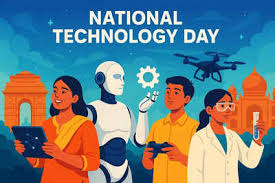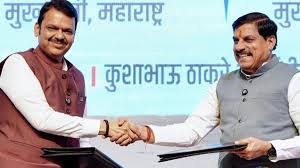Today’s Current Affairs: 13th May 2025 for UPSC IAS exams, State PSC exams, SSC CGL, State SSC, RRB, Railways, Banking Exam & IBPS, etc
Table of Contents
National Technology Day 2025:

The Technology Development Board (TDB) under the Department of Science and Technology (DST) has announced the official theme for National Technology Day 2025 as: “YANTRA – Yugantar for Advancing New Technology, Research & Acceleration.”
- National Technology Day is observed annually on 11th May to commemorate key milestones in India’s technological advancement.
- Pokhran-II Nuclear Tests under Operation Shakti, establishing India as a nuclear weapons state.
- First test flight of the indigenously developed “Hansa-3” aircraft at Bengaluru.
- Successful test firing of the Trishul missile, a short-range surface-to-air missile developed by DRDO.
- The day was officially declared by then Prime Minister Atal Bihari Vajpayee in 1998, and since 1999, it has been celebrated as National Technology Day.
- The event is organised by the Technology Development Board (TDB), a statutory body under DST, which promotes the commercialisation of indigenous technologies.
- The word “YANTRA”, drawn from India’s ancient scientific and cultural traditions, signifies not just mechanical tools but also symbolic power representing: Systems thinking, Synergistic innovation, Scalable technological solutions
- The term “Yugantar”, meaning epochal transformation, reflects India’s transition from technology adoption to global technology leadership, signalling a shift in India’s innovation narrative.
National Scheme for Upgradation of Industrial Training Institutes (ITIs) and the establishment of five National Centres of Excellence (NCOEs) for Skilling:

The Union Cabinet recently approved the National Scheme for Industrial Training Institute (ITI) Upgradation and the Setting up of five National Centres of Excellence for Skilling as a Centrally Sponsored Scheme.
- It will be implemented as a Centrally Sponsored Scheme with an outlay of Rs.60,000 crore (Central Share: Rs.30,000 crore, State Share: Rs.20,000 crore, and Industry Share: Rs.10,000 crore), with co-financing to the extent of 50% of the Central share by the Asian Development Bank and the World Bank,
- The scheme will focus on upgradation of 1,000 Government ITIs in hub and spoke arrangement with industry aligned revamped trades (courses) and Capacity Augmentation of five (5) National Skill Training Institutes (NSTIs), including setting up of five National Centres of Excellence for Skilling in these institutes.
- The Scheme aims to position existing ITIs as government-owned, industry-managed aspirational institutes of skills, in collaboration with State Governments and industry.
- Over a five-year period, 20 lakh youth will be skilled through courses that address the human capital needs of industries.
- The scheme will focus on ensuring alignment between local workforce supply and industry demand, thereby facilitating industries, including MSMEs, in accessing employment-ready workers.
- A need-based investment provision has been kept under the scheme, allowing flexibility in fund allocation based on the specific infrastructure, capacity, and trade-related requirements of each institution.
- A unique feature of this scheme is the introduction of an industry-led Special Purpose Vehicle (SPV) model to oversee ITI upgradation.
- This approach will ensure better industry participation, course alignment, and outcome-driven implementation.
- Under the scheme, infrastructure upgradation for improved Training of Trainers (ToT) facilities will be undertaken in five NSTIs, namely Bhubaneswar, Chennai, Hyderabad, Kanpur, and Ludhiana.
- Additionally, pre-service and in-service training will be provided to 50,000 trainers.
Credit Guarantee Scheme for Startups : Expansion

The Centre recently notified an expansion of the Credit Guarantee Scheme for Startups (CGSS).
- The Government of India established the CGSS in 2022 for providing credit guarantees to loans extended by Scheduled Commercial Banks, Non-Banking Financial Companies (NBFCs), and Securities and Exchange Board of India (SEBI)-registered Alternative Investment Funds (AIFs).
- CGSS is aimed at providing credit guarantees up to a specified limit against loans extended by Member Institutions (MIs) to finance eligible borrowers, viz., Startups as defined in the Gazette Notification issued by Department for Promotion of Industry and Internal Trade (DPIIT) and amended from time to time.
- The National Credit Guarantee Trustee Company Limited (NCGTC) is the implementing agency of the Scheme.
- CGSS does not provide guarantee cover to DPIIT-recognised startups directly, but the Trustee (NCGTC), which in turn provides guarantee cover to Member Institutions (MIs) who provide loans to startups.
- The instruments of assistance would be in the form of venture debt, working capital, subordinated debt/mezzanine debt, debentures, optionally convertible debt and other fund-based as well as non-fund-based facilities, which have crystallised as debt obligations.
- The credit guarantee cover under the Scheme would be transaction-based and umbrella-based.
- In transaction-based guarantee cover, the guarantee cover is obtained by the MIs on a single eligible borrower basis. It will promote lending by Banks/ NBFCs to eligible startups.
- The umbrella-based guarantee cover will provide guarantee to Venture Debt Funds (VDF) registered under AIF regulations of SEBI.
- The revised framework has enhanced guarantee coverage, increasing the maximum limit from ₹10 crore to ₹20 crore per eligible borrower.
- The extent of guarantee has also been increased. For loans up to ₹10 crore, the guarantee will now cover 85 percent of the amount in default, while for loans above ₹10 crore, the coverage will be 75 percent.
- Further, the Annual Guarantee Fee (AGF) for startups in 27 Champion Sectors has been reduced to 1 percent p.a. from 2 percent p.a.
LICONN Technology:

Scientists recently developed a way to map how brain cells are connected using light microscopes in a technique called LICONN.
- Light-microscopy-based Connectomics (LICONN) is a new method to map the brain’s complex neural networks at the nanoscale while simultaneously identifying specific molecules within those connections.
- It was developed at the Institute of Science and Technology Austria (ISTA).
- LICONN combines conventional light microscopy technology with the properties of hydrogel and experimental techniques, artificial intelligence, and analytical methods.
- It is the first technology beyond electron microscopy (EM) that is capable of reconstructing brain tissue with all the synaptic connections between neurons.
- Until now, researchers studying brain connectivity faced a challenging trade-off: they could either see the detailed physical structure of neural connections using electron microscopy (EM) or identify specific molecules using light microscopy—but not both simultaneously at the resolution needed to trace individual connections.
- LICONN allows researchers to see structures in the brain that are smaller than what normal light microscopes can detect.
- They do this by soaking brain tissue in a special gel that expands it by about 16 times its original size, then use fluorescent stains to highlight different proteins and advanced computer programs, including AI, to identify and trace the shapes of neurons.
Tapti Basin Mega Recharge Project:

The governments of Madhya Pradesh and Maharashtra recently signed a Memorandum of Understanding (MoU) to jointly implement the Tapti Basin Mega Recharge Project.
- The Tapti River (called Tapi in Maharashtra) originates in Madhya Pradesh’s Betul district and flows through parts of Maharashtra.
- TBMRP is a joint project of Madhya Pradesh and Maharashtra.
- It is the world’s largest groundwater recharge initiative.
- The project aims to channelise adequate water to northeastern Maharashtra, including Nagpur, for drinking purposes, and to southern Madhya Pradesh, particularly the Chhindwara district, for irrigation.
- The total water usage of the Tapti Basin Mega Recharge Project will be 31.13 thousand million cubic feet (TMC), of which 11.76 TMC has been allocated to Madhya Pradesh and 19.36 TMC to Maharashtra.
- It will facilitate irrigation of 1,23,082 hectares of land in MP and 2,34,706 hectares in Maharashtra.
- Under the Project, four water structures are proposed:
- Low diversion weir at Kharia Gutighat dam site: The weir is proposed at Khalwa tehsil of Khandwa district in MP and Amravati tehsil of Maharashtra on the border of both states with 8.31 TMC capacity.
- Right bank canal phase I: A 221-km-long canal is proposed from the right bank of the proposed Kharia Gutighat weir, with 110 km in MP. The canal will irrigate over 55,000 hectares of area in MP.
- Left bank canal phase I: A 135.64-km-long canal is proposed from the left bank of the proposed Kharia Gutighat weir, with 100.42 km in MP. It will irrigate over 44,000 hectares of area in MP.
- Left bank canal phase II: Its length will be 123.97 km, which will irrigate over 80,000 hectares in Maharashtra.
Predatory Pricing:

The Competition Commission of India (CCI) has notified the Determination of Cost of Production Regulations, 2025, to regulate predatory pricing, particularly targeting e-commerce and quick commerce platforms.
- Predatory pricing, defined under the Competition Act, 2002, refers to a strategy where a company deliberately lowers its prices below the cost of production to reduce competition and eliminate competitors.
- Once competitor firms are weakened or eliminated, the company typically raises prices to recoup its losses and consolidate market control (monopoly).
- New regulations replaced the 2009 rules by removing market value as a benchmark and redefining total cost to include depreciation and exclude financing overheads (daily business expenses) for greater clarity.
- It uses a sector-agnostic (neutral), case-by-case approach, better suited for dynamic digital markets.
- CCI is a statutory body established under the Competition Act, 2002 to promote fair competition, prevent anti-competitive practices, and protect consumer interests.
Geostrategic Passes Connecting Kailash Mansarovar Yatra:

India announced the resumption of the Kailash Mansarovar Yatra (KMY) after a 5-year pause, halted by China in 2020 due to Covid-19 and Line of Actual Control (LAC) tensions. KMY has been operational since 1981.
- KMY is a pilgrimage organized by the Ministry of External Affairs (India) to Mount Kailash (6,638 m) and Lake Mansarovar (4,600 m) in the Tibet Autonomous Region (TAR) of China.
- Official Operational Routes (as of 2025):
- Lipulekh Pass (Uttarakhand): It is the shortest route to Mansarovar (50 km from the border), but rough terrain extends the trek to 200 km.
- It was the first Indian border post opened for trade with China in 1992, followed by Shipki La (1994) and Nathu La (2006).
- Nathu La Pass (Sikkim): This 1,500 km fully motorable route (it is one of the world’s highest motorable roads) opened in 2015; easier for pilgrims, no trekking needed.
- Nathu La connects Sikkim with China’s TAR and is part of the ancient Silk Road.
Sarvam AI Launches Bulbul-v2 with Realistic Indian Accents:
Bengaluru-based AI startup Sarvam AI has launched its latest text-to-speech (TTS) model, Bulbul-v2, designed specifically to cater to India’s diverse linguistic landscape. Supporting 11 Indian languages, the model offers natural, human-like voices with authentic regional accents, making it a promising tool for businesses, brands, and developers seeking voice customisation for Indian audiences.
Delhi Police Launches ‘Nayi Disha’ to Reintegrate School Dropouts:
In a commendable shift from conventional policing to community empowerment, the Delhi Police has launched a new initiative called ‘Nayi Disha – A Path Back to Learning’ to reintegrate school dropouts into the formal education system. Through proactive community engagement and collaboration with NGOs and schools, the police aim to reduce dropout rates and foster educational continuity for disadvantaged children.Sarvam AI’s release of Bulbul-v2 marks a significant leap in India’s speech AI ecosystem, offering India-first pricing, low latency, and custom voice options. The model’s launch also aligns with the company’s role in developing India’s sovereign large language model under the IndiaAI mission.
Justice Surya Kant Appointed as NALSA Executive Chairman:
Justice Surya Kant, a sitting judge of the Supreme Court of India, has been appointed as the new Executive Chairman of the National Legal Services Authority (NALSA) by the President of India. His appointment, effective from May 14, 2025, aligns with the tradition of nominating the second senior-most judge of the apex court to this role. Justice Kant will now spearhead the national mission to provide free legal aid and promote access to justice for the underprivileged.
Rajnath Singh Launches BrahMos Manufacturing Facility in Lucknow:
Defence Minister Rajnath Singh virtually inaugurated the BrahMos supersonic cruise missile production facility at the Uttar Pradesh Defence Industrial Corridor in Lucknow. Built with an investment of ₹300 crore, the unit aims to manufacture 80–100 BrahMos missiles annually, significantly enhancing India’s self-reliance in defence manufacturing amid growing regional security concerns.The inauguration of the BrahMos missile manufacturing facility has brought India a step closer to achieving defence self-sufficiency under the “Atmanirbhar Bharat” initiative. It comes at a time of heightened military tensions with Pakistan and marks a critical milestone in indigenous missile production, particularly with the production of next-generation BrahMos variants.
Ceasefire Declared Between India and Pakistan Amid Escalating Tensions:
India and Pakistan have agreed to a full and immediate ceasefire, following mediation efforts led by the United States. The announcement came after US President Donald Trump shared a post on Truth Social congratulating both countries for exercising “common sense and great intelligence.” The decision was confirmed by India’s Foreign Secretary Vikram Misri, who revealed that the ceasefire will take effect from 5:00 PM IST on May 10, 2025, marking a significant pause in cross-border hostilities that had intensified in recent days.The ceasefire announcement comes after a night of heavy cross-border shelling, drone attacks, and air raids between India and Pakistan, especially along the Line of Control (LoC) in Jammu and Kashmir. Tensions had peaked after casualties were reported on both sides, prompting urgent diplomatic intervention by the US.
Madhya Pradesh and Maharashtra Join Hands for Tapti Basin Mega Recharge Project:
In a landmark move aimed at securing water resources and promoting inter-State cooperation, Madhya Pradesh and Maharashtra signed an MoU on May 10, 2025, to jointly implement the Tapti Basin Mega Recharge Project. The agreement seeks to mitigate water scarcity and improve irrigation across select districts of both States, especially in Vidarbha, North Maharashtra, and Southern Madhya Pradesh.The Tapti Basin Mega Recharge Project gained national attention after Madhya Pradesh Chief Minister Mohan Yadav and Maharashtra Chief Minister Devendra Fadnavis signed a Memorandum of Understanding (MoU) in Bhopal on May 10, 2025. The project marks a major step forward in water-sharing cooperation between States and aims to receive national project status and 90% Central funding.
RBI Slaps Penalties on SBI and Jana Small Finance Bank for Regulatory Lapses:
The Reserve Bank of India (RBI) has imposed monetary penalties on two banks — State Bank of India (SBI) and Jana Small Finance Bank — for deficiencies in compliance with banking norms. The action underlines the central bank’s strict approach toward ensuring discipline and customer protection in India’s financial sector.The RBI announced on May 9, 2025, that it has imposed: A penalty of ₹1.72 crore on SBI and A penalty of ₹1 crore on Jana Small Finance Bank. These penalties are for non-compliance with specific directives related to loans, customer liability, and regulatory provisions under the Banking Regulation Act, 1949.
India Prohibits Use of Key Antimicrobials in Aquaculture to Combat Antimicrobial Resistance:
The Union Ministry of Commerce and Industry issued a landmark decision to prohibit the use of several medically important antimicrobials in India’s aquaculture sector. This move comes in response to growing concerns about antimicrobial resistance (AMR), which is fueled by the misuse of antibiotics in food production, including aquaculture. This prohibition, which includes a wide range of antibiotics, antivirals, and antiprotozoals, aims to protect both public health and India’s booming seafood export industry.




